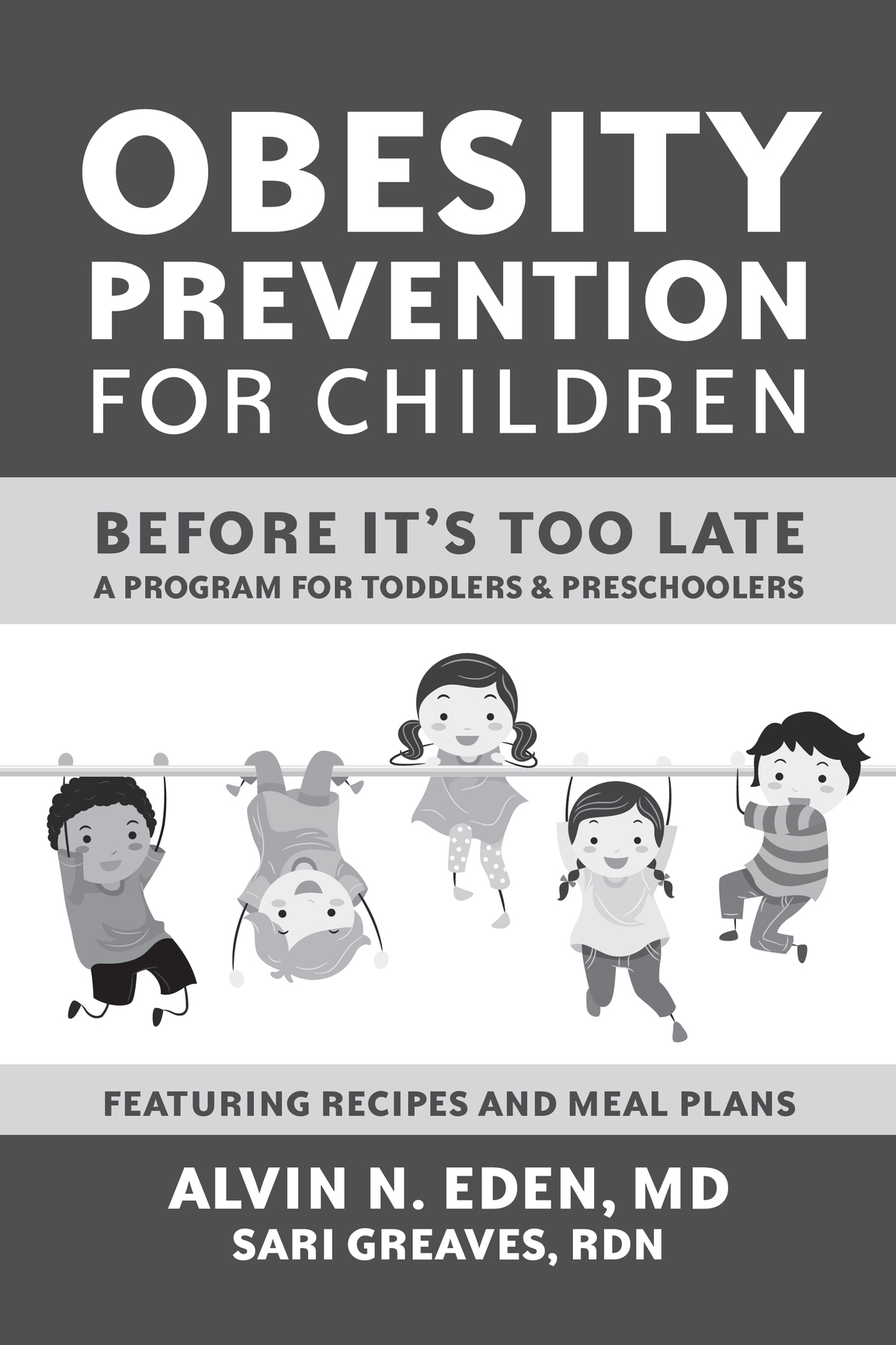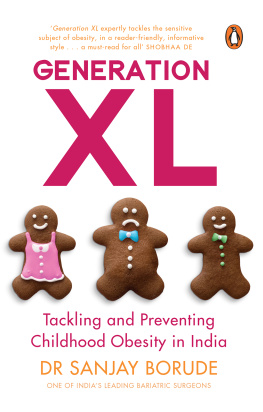Contents
Dr Eden does parents of young children a great service in Obesity Prevention for Children. He provides a lucid and succinct review of the causes of early childhood obesity, along with many straight-forward tips learned from decades of pediatric practice on how to prevent this problem. This important work will be of help to all parents in keeping their offspring healthy for life.
J.A. Stockman III, MD
Professor of Pediatrics, Duke University Medical Center Past President, American Board of Pediatrics
A fun, easy to read common-sense guide for parents and grandparents wanting not only to avoid obesity in their children but also to help children acquire lifetime good nutrition and exercise habits. The advice is basic, old-school pediatrics written in a style that speaks to Dr. Edens years of experience as a pediatrician guiding pediatric patients and parents.
Gerald M. Loughlin, MD, MS
Chairman, Department of Pediatrics, Weill Cornell Medicine and Pediatrician-in-Chief, New York-Presbyterian Hospital
Obesity Prevention for Children reflects 40 years of clinical practice by an unusually astute, highly competent, and compassionate clinician with a particular interest in nutrition and obesity. Of great value is Dr. Edens anecdotal examples of obese patients and their families which offers useful new information on obesity. This book is a must have for all parents and professionals dealing with obesity.
Philip Lanzkowsky, MD, ScD, FAAP
Professor of Pediatrics, Hofstra-Northwell School of Medicine
This practical, no-nonsense book, written by an experienced pediatrician and leading expert on childhood obesity, will be useful for every parent. The real-life stories are drawn from Dr. Edens extensive experiences as a practicing pediatrician, and breathe life into his advice and provide encouragement.
Michael Weitzman, MD
Professor of Pediatrics, Environmental Medicine, and Global Public Health at the New York University School of Medicine
Dr. Edens philosophy is easy to put into practice and involves the entire family so that all can benefit from his wisdom. As parents and pediatricians, we must strive to prevent childhood illnesses, especially those that will impact our children as they become adults. Kudos to Dr. Eden, a world-class physician, mentor, and all-around great guy, for helping our children stay fit and trim!
Claudio Sandoval, MD
Professor of Pediatrics, New York Medical College Attending Pediatric Hematologist Oncologist, Maria Fareri Childrens Hospital
Finally, practical advice to prevent obesity from startingthe only way to really address the obesity epidemic. A must read for parents today. This text combines the latest scientific nutritional studies with simple, practical advice to prevent obesityall with a conversational-style text. What more could parents ask for?
Michael J. Pettei, MD, PhD
Associate Professor of Pediatrics, Hofstra-Northwell School of Medicine Director, Division of Pediatric Gastroenterology and Nutrition, Cohen Childrens Medical Center of New York, Northwell Health Co-chairperson, Nutrition Committee, American Academy of Pediatrics, NY Chapter 2


Hatherleigh Press is committed to preserving and protecting the natural resources of the earth. Environmentally responsible and sustainable practices are embraced within the companys mission statement.
Visit us at www.hatherleighpress.com and register online for free offers, discounts, special events, and more.
Obesity Prevention for Children
Text Copyright 2016 Alvin Eden, M.D.
Library of Congress Cataloging-in-Publication Data is available.
ISBN: 978-1-57826-647-0
Ebook ISBN: 978-1-57826-650-0
All rights reserved. No part of this book may be reproduced, stored in a retrieval system, or transmitted, in any form or by any means, electronic or otherwise, without written permission from the publisher.
B OOK D ESIGN BY C AROLYN K ASPER
v4.1
CONTENTS
INTRODUCTION
I N 1975 , I PUBLISHED MY first book, Growing Up Thin, which addressed the problem of obesity in children. It was a huge success and received a great deal of publicity. Yet despite these efforts, 40 years later children are fatter than ever.
So what happened during these past 40 years?
More and more meals are being eaten in fast-food establishments.
Portions sizes are now larger.
Besides TV, we now have computers, cell phones, and tablets for children, all of which increase sedentary timewhat I call S.O.B. Syndrome (Sitting On Butt).
Physical education time in schools has become more limited.
More safety issues associated with outdoor play, such as increased automobile traffic and fear of abduction.
In truth, the obesity problem actually dates back to the 1950s, during which period food production in the United States dramatically increased. Starting at that time, billions of dollars began being spent to produce and market high-density, high-calorie foods at a relatively low expense to the consumer. According to a New York Times report in August 2008, sugar consumption rose by nearly 33 percent due to the use of high fructose corn syrup alone. The average American was now eating 1.8 more pounds of food each week.
The statistics are frightening. About 6 percent of Americans were obese in the 1950s, rising to 25 percent by the 1970s. Today, the figure is about 35 percent. The prevalence of childhood obesity has also increased significantlytwo- to three-foldjust in the past few decades. An early childhood longitudinal study of over 7,000 children published in the New England Journal of Medicine (July 2014) showed that over 25 percent of children entering kindergarten were either overweight or obese. These overweight and obese kindergarteners were four times as likely to have remained obese into the 8th grade, as compared to children of normal weight entering kindergarten. In fact, nearly two out of every three children who enter kindergarten obese will remain obese as teenagers; in turn, most of those will end up obese as adults. In other words, if your child starts kindergarten overweight or obese, he will be at an extremely high risk of remaining that way throughout childhood and beyond.
The current childhood obesity epidemic is in large measure due to the modern high density, high calorie sugar-laden diet. This, together with a more sedentary life style explains why today we have so many overweight and obese children (and adults). Yet the consequences of developing obesity as a child are well known: in addition to reducing an individuals overall lifespan, other negative results include the development of type 2 diabetes, elevated cholesterol, orthopedic problems, sleep apnea, and a variety of psychological/social problems brought on due to a lack of self-esteem and self-worth. Obese children are also more likely to be bullied and socially isolated.
Whats worse, this epidemic of childhood obesity has remained with us despite massive efforts to halt it in placeor at least slow it down. Up to this point, the majority of our efforts have been unsuccessful, if well intentioned. The answer is obvious. Having been a practicing pediatrician for over 40 years now, with a particular interest in this subject, my experience (as well as that of many other physicians caring for obese children) strongly suggests that the treatment of both school age and adolescent obesity is almost always unsuccessful. Sad though it is to say, the treatment of obese school-age children and older teenager is usually doomed to fail.











